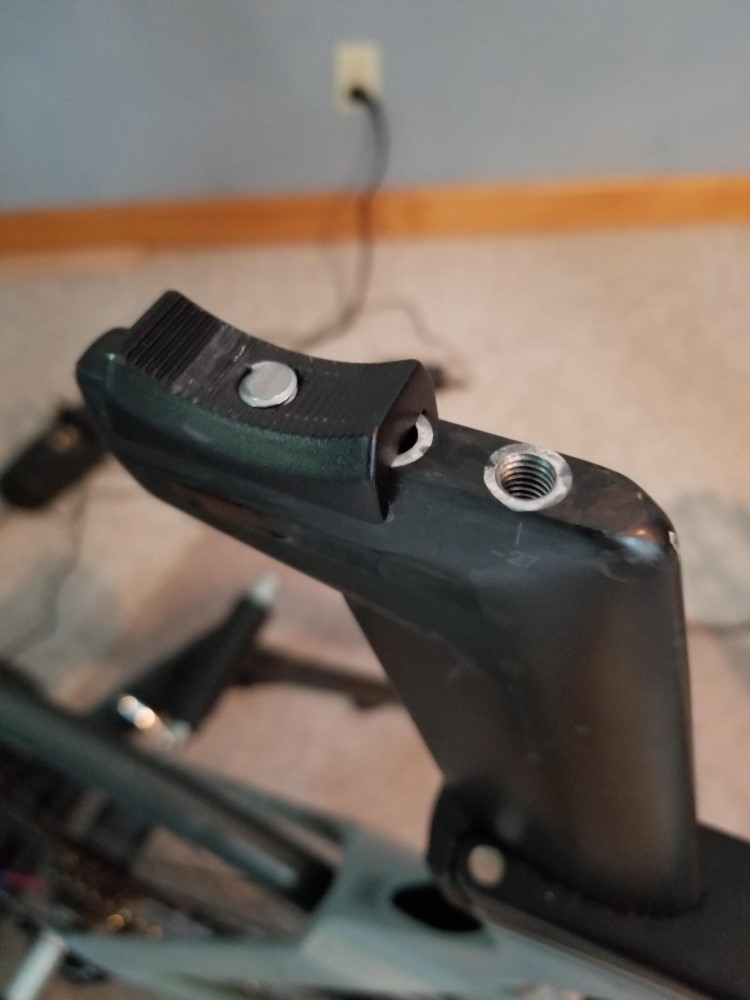Any idea why the bolt fails?
Bottom line: I believe the bolt fails because the seat post clamping mechanism design causes fatigue in the bolt.
ASTM E1823-10a, Terminology Relating to Fatigue and Fracture Testing, defines fatigue as:
The process of progressive localized permanent structural change occurring in a material subjected to conditions that produce fluctuating stresses and strains at some point or points and that may culminate in cracks or complete fracture after a sufficient number of fluctuations.
"Fastener Fatigue" Fastenal.com
The article linked above contains many pictures and detailed descriptions of how to diagnose many aspects of fatigue failure.
What it boils down to is that the bolt was flexed back and forth - subjected to "fluctuating stresses and strains" in the same place until it broke.
The fastener assembly process is one of the
most important, but often overlooked, contributors to fatigue performance. The cyclic-stress
amplitude imposed on a given fastener (and therefore fatigue performance) is highly dependent on preload. Specifically, increased preload results in decreased cyclic stress-amplitude, particularly at loads below the clamping force imposed by the fastener.
Fatigue of Threaded Fasteners
So, in general tighter bolts are less susceptible to fatigue failure.
The "Fatigue of Threaded Fasteners" article goes on to say:
The concept of higher preloads resulting in increased fatigue performance may be counterintuitive, which might otherwise suggest that increasing the tightening force of a bolt may increase propensity for failure. Insufficient preload has
been attributed to the cause of the majority of fastener fatigue failures.
Later it says that excessive preloads are bad. It should be tight but not too tight.
Possible issues
- Riding your bike generates the forces that caused the fatigue failure..
Riding the bike is normal usage - the clamping mechanism should be designed to handle the force it's being subjected to.
- Since the bolt was tightened to spec by the shop on the second bolt we can assume that tightening was not the issue.
- A bad bolt? It is possible but I think unlikely to have two bad bolts in a row.
- Is the bolt too weak? a rating of 12.9 is very very good. The bolt should be up to the task.
- Does the design of the clamp place cyclic stresses on the bolt?
I think an argument could be made that since the break is just above the bottom seat angle adjustment mechanism of the clamp that the design focuses cyclic stress on the bolt at that point, especially if both bolts broke in the same place.
If you had a bolt that was shank just past the point where this bolt broke it might last longer - a longer grip length.
This is a little crazy and you shouldn't even have to think about this but it might be possible to make it last longer by riding softer. Sometimes it's possible to mitigate poor design by changing behavior.

Wikipedia
Edit:
The bolt in your post is 12.9 which is a metric rating.
There is no bolt greater strength than 12.9
Metric Class 12.9 The highest metric class for strength, it exceeds Grade 8.
Fasternermart.com
Some of the comments reflect the fact that there are counterfeit bolts - one that has a rating stamped on it that it does not deserve.
If you broke a real 12.9 bolt there is no better bolt to get. To make sure you are using a real 12.9 bolt you need to get one from a reputable source.






